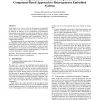Free Online Productivity Tools
i2Speak
i2Symbol
i2OCR
iTex2Img
iWeb2Print
iWeb2Shot
i2Type
iPdf2Split
iPdf2Merge
i2Bopomofo
i2Arabic
i2Style
i2Image
i2PDF
iLatex2Rtf
Sci2ools
GPCE
2007
Springer
2007
Springer
42: programmable models of computation for a component-based approach to heterogeneous embedded systems
Every notion of a component for the development of embedded systems has to take heterogeneity into account: components may be hardware or software or OS, synchronous or asynchronous, deterministic or not, detailed w.r.t. time or not, detailed w.r.t. data or not, etc. A lot of approaches, following Ptolemy, propose to define several “Models of Computation and Communication” (MoCCs) to deal with heterogeneity, and a framework in which they can be combined hierarchically. This paper presents the very first design of a component model for embedded systems called 42. We aim at expressing fine-grain timing aspects and several types of concurrency as MoCCs, but we require that all the MoCCs be “programmed” in terms of more imitives. 42 is meant to be an abstract description level, intended to be translated into an existing language (e.g., Lustre) for execution and property validation purposes. Keywords Heterogeneous embedded systems, component-based design, semantics, models-of-co...
Artificial Intelligence | Detailed W.r.t | Embedded Systems | GPCE 2007 | fine-grain Timing Aspects |
| Added | 07 Jun 2010 |
| Updated | 07 Jun 2010 |
| Type | Conference |
| Year | 2007 |
| Where | GPCE |
| Authors | Florence Maraninchi, Tayeb Bouhadiba |
Comments (0)

